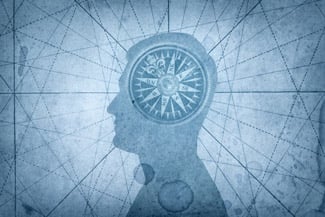Do we have an internal compass?
 We all know that migratory birds and sea turtles have a geomagnetic sense that supports their sense of direction. This sensory modality has been studied in vertebrates and even in certain invertebrates (like bees and lobsters). It has long been believed that humans also possess a form of magnetoreception, but the ability has never been demonstrated scientifically. A recent study has just revealed that our brain may come with an internal compass...
We all know that migratory birds and sea turtles have a geomagnetic sense that supports their sense of direction. This sensory modality has been studied in vertebrates and even in certain invertebrates (like bees and lobsters). It has long been believed that humans also possess a form of magnetoreception, but the ability has never been demonstrated scientifically. A recent study has just revealed that our brain may come with an internal compass...For migratory animals, magnetoreception (their ability to detect Earth’s magnetic field) allows them to build a sort of “map” that helps them navigate. In the 1980s, researchers attempted to demonstrate this ability in humans. For example, the biologist Robin Baker (University of Manchester, United Kingdom) carried out an experiment that tested his students’ ability to identify their point of departure after being transported blindfolded to an unknown location. The subjects were naturally able to find their bearings, except when they had a magnet attached to their foreheads! But subsequent attempts to replicate these results have failed.
Nearly 40 years later, a team of American and Japanese geoscientists, neuroscientists, and neuro-engineers claim to have demonstrated humans’ ability to sense the Earth’s magnetic field. Rather than observing behavioral responses, they used electroencephalography (EEG) to directly analyze how the participants’ brains reacted in response to magnetic field manipulation. Specifically, one-by-one they asked 34 participants to enter a dark room that was isolated from the earth’s magnetic field (the room was lined with thin aluminum foil). They then asked each participant to sit in silence for an hour. Meanwhile, using a network of electric coils placed throughout the room, the scientists exposed each participant (wearing an EEG electrode helmet) to magnetic fields. The scientists observed brain activity while activating the various magnetic fields.
Specifically, the researchers tracked what is known as the alpha rhythm, which occurs at between eight and thirteen Hertz and which determines whether the brain is in “resting” or “autopilot” mode, or engaged in an activity. Note that when our brain is “resting,” alpha power is high, but when something consciously or unconsciously catches our attention (sensory input, for example), its alpha power decreases. Therefore, Kirschvink and his colleagues decided to rely on the variations in these alpha waves to see whether the participants were able to sense the magnetic field.
The researchers noticed that certain participants showed changes in their brain waves that correlated with the magnetic field surrounding them. In these participants, a drop in the amplitude of the alpha oscillations was identified following geomagnetic stimulation. This is the same pattern seen in a classical response to sensory input (such as a sound or odor). According to Kirschvink: “Given the known presence of highly evolved geomagnetic navigation systems in species across the animal kingdom, it is perhaps not surprising that we might retain at least some functioning neural components, especially given the nomadic hunter-gatherer lifestyle of our not-too-distant ancestors.”
The neuronal response to magnetic fields only occurred after horizontal rotations, when the static vertical magnetic field was directed downwards (as in the northern hemisphere). However, the same horizontal rotations failed to produce a reaction in the brain when the field was "flipped" upwards (as in the southern hemisphere). According to the authors, this indicates a biological response adapted to the ecology of the 34 participants, who all grew up in the northern hemisphere: “it seems that the brain is ignoring signals that are obviously ‘wrong’.”
In conclusion, the scientists encourage other research teams to reproduce and extend their work to more thoroughly demonstrate geomagnetic sense in humans.
Source: Connie X. Wang, Isaac A. Hilburn, Daw An Wu, Yuki Mizuhara, Christopher P. Cousté, Jacob NH Abrahams, Sam E. Bernstein, Ayumu Matani, Shinsuke Shimojo et Joseph L. Kirschvink. “Transduction of the Geomagnetic Field as Evidenced from Alpha-band Activity in the Human Brain”, in E Neuro , March 2019 // California Institute of Technology (Caltech) website: “Evidence for a Human Geomagnetic Sense”: https://www.caltech.edu/about/news/evidence-human-geomagnetic-sense







